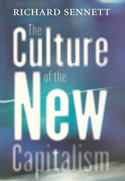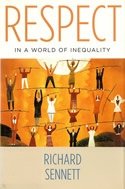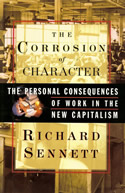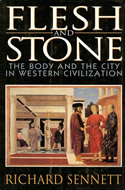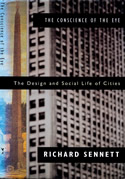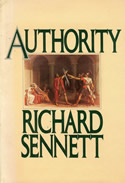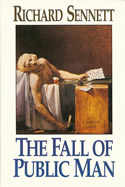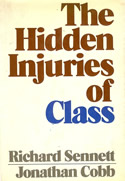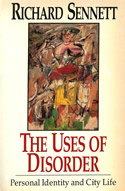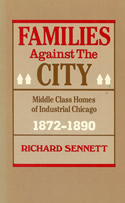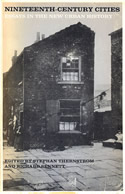Richard Sennett - Sociology books#
The Craftsman
The Craftsman names a basic human impulse: the desire to do a job well for its own sake. Although the word may suggest a way of life that waned with the advent of industrial society, Sennett argues that the craftsman’s realm is far broader than skilled manual labor; the computer programmer, the doctor, the parent, and the citizen need to learn the values of good craftsmanship today.
The Craftsman leads Richard Sennett across time and space, from ancient Roman brickmakers to Renaissance goldsmiths to the printing presses of Enlightenment Paris and the factories of industrial London. History has drawn fault lines dividing practice and theory, technique and expression, craftsman and artist, maker and user; modern society suffers from the historical inheritance. But the past life of craft and craftsmen also suggests ways of using tools, organizing work, and thinking about materials that remain alternative, viable proposals about how to conduct life with skill.
New Haven: Yale University Press, 2008; London: Allen Lane/Penguin Press, 2008; Berlin: Berlin Verlag, 2008; Milan: Feltrinelli, 2008; Paris: Albin Michel, 2009; Barcelona: Anagrama, 2009
Practicing Culture
The essays in Practicing Culture seek to revitalize the field of cultural sociology. They show how to put theoretical sources to work in empirical research. Culture is a set of practices rather than static representations; culture is made and remade in countless small ways and occasional bursts of innovation. Culture is something people do.
Oxon: Routledge, 2007
The Culture of the New Capitalism
In The Culture of the New Capitalism, Richard Sennett surveys the major differences between earlier forms of industrial capitalism and the more global, more febrile, ever more mutable version of capitalism that is taking its place. He shows how these changes affect everyday life – how the work ethic is changing; how new beliefs about merit and talent displace old values of craftsmanship and achievement; how what Sennett calls “the specter of uselessness” haunts professionals as well as manual workers; how the boundary between consumption and politics is dissolving.
In recent years, reformers of both private and public institutions have preached that flexible, global corporations provide a model of freedom for individuals, unlike the experience of fixed bureaucracies Max Weber once called an “iron cage.” Sennett argues that, in banishing old ills, the new-economy model has created new social and emotional traumas. Only a certain kind of human being can prosper in unstable, fragmentary institutions: the culture of the new capitalism demands an ideal self oriented to the short term, focused on potential ability rather than accomplishment, willing to discount or abandon past experience.
New Haven: Yale University Press, 2005; Berlin: Berlin Verlag, 2005 ; Paris: Albin Michel, 2006; Milan: Il Mulino, 2006; Barcelona, Anagrama, 2006
Respect, In an Age of Inequality
In the uncertain world of “flexible” social relationships, all are troubled by issues of respect: whether it be an employee stuck with insensitive management, a social worker trying to aid a resentful client, or a virtuoso artist and an accompanist aiming for a perfect duet.
Opening with a recollection of growing up in Chicago’s infamous Cabrini Green housing project, Sennett explores the factors that make mutual respect so difficult to achieve. Even in a perfect world, inequalities of ability remain. Adults who are dependent face challenges in earning both self-respect and respect from others. Compassion degrades into condescension, due to both impersonal bureaucracy and intrusive volunteerism.
In Respect, In a Age of Inequality, Sennett investigates from the world of music how self-worth can be nurtured in an unequal society, how self-esteem must be balanced with feeling for others, and how mutual respect can forge bonds across the divide of inequality.
New York: W.W. Norton, 2003; London: Penguin, 2002; Berlin: Berlin Verlag, 2002; Paris: Albin Michel, 2003; Barcelona, Anagrama, 2003; Amsterdam, Byblos, 2003; Milan: Il Mulino, 2004; Moscow, Russian Academy of Sciences, 2004. In preparation: Greece, China, Japan, Korea, Denmark
The Corrosion of Character: The Personal Consequences of Work in the New Capitalism
Drawing on interviews with dismissed IBM executives in Westchester, New York, bakers in a high-tech Boston bakery, a barmaid turned advertising executive, and many others, Sennett explores the disorienting effects of the new capitalism. He reveals the vivid and illuminating contrast between two worlds of work: the vanished world of rigid, hierarchical organizations, where what mattered was a sense of personal character, and the brave new world of corporate re-engineering, risk, flexibility, networking, and short-term teamwork, where what matters is being able to reinvent yourself on a dime.
In some ways the changes characterizing the new capitalism are positive; they make for a dynamic economy. But they can also be destructive, eroding the sense of sustained purpose, integrity of self, and trust in others that an earlier generation understood as essential to personal character. The Corrosion of Character enables us to understand the social and political context for our contemporary confusions and Sennett suggests how we need to re-imagine both community and individual character in order to confront an economy based on the principle of “no long term.”
New York: W.W. Norton, 1998; London: W.W. Norton, 1998; Berlin: Berlin Verlag, 2002; Sau Paulo: Record, 1999; Lisbon: Terramar, 2000; Madrid: Anagrama, 1999; Milan: Feltrinelli, 1999; Paris: Albin Michel, 2000; Copenhagen: Hoveland, 2000; Amsterdam, Byblios, 2000; Tokyo, Saito, 2000; trans. In preparation: Greece, Russia, Korea, Turkey, China
Flesh and Stone: The Body and the City in Western Civilization
Flesh and Stone is a history of the city in Western civilization, one that tells the story of urban life through bodily experience. It recounts how women and men moved in public and private spaces, what they saw and heard, the smells that assailed their noses, where they ate, how they dressed, the mores of bathing and of making love – all in the spaces of the city from ancient Athens to modern New York.
This is a book that takes seriously people’s bodily needs, beliefs, and actions as a way to understand urban form in the past. In the present: we want to build more sensate and arousing cities.
New York: W.W. Norton, 1994; London: Faber and Faber, 1994; Berlin: Berlin Verlag, 1997. Paris: Editions de la Passion, 2003. Madrid: Alianza, 1997. Rio: Compania das Letras, 1996. Translations in process: Poland, Holland, Japan
The Conscience of the Eye
With an eye toward the architecture, the art, the literature, and the technology of urban life, Richard Sennett gives an account of the search for shelter and the fear of exposure to strangers and new experience in Western culture – and how these two concerns have shaped the physical fabric of the city.
“Why do we avert our eyes when we encounter the unaccustomed?” asks Sennett. In answer, he moves between past and present from the assembly hall of Athens to the Palladium Club; from Augustine’s City of God to the Turkish baths of the Lower East Side; from eighteenth-century English gardens to the housing projects of East Harlem; from Nietzsche’s Birth of Tragedy to subway graffiti. The Conscience of the Eye is an exploration of the politics of vision.
New York: Knopf, 1991. London: Faber and Faber, 1991. London: Norton, 1992. Frankfurt: S. Fischer Verlag, 1991. Paris: Plon,1991. Re-issued Berlin: Berlin Verlag, 2008. Re-issued Paris: Editions de la Passion, 2006. Milan: Feltrinelli, 1991. Barcelona: Versal, 1991. Sao Paulo: Campania das Letras, 1992; Toyko: Inwanami Shotun, 1999. Translation in process: Denmark
"The Social Sciences and Visual Studies," a special issue of the International Journal of the Social Sciences, edited by Richard Sennett. New York: United Nations Printing Office, 1990.
Authority
In Authority, Sennett analyzes the nature, the role, and the faces of authority – authority in personal life, in the public realm, authority as an idea. Why have we become so afraid of authority? What real needs for authority do we have – for guidance, stability, images of strength? What happens when our fear of and our need for authority come into conflict? In exploring these questions, Sennett examines traditional forms of authority (the father’s in the family, the lord’s in society) and the dominant contemporary styles of authority, and he shows how our needs for no less than our resistance to authority have been shaped by history and culture, as well as by psychological disposition.
Sennett explores the bonds that rebellion against authority paradoxically establishes – how in the very act of rebelling we become more and more tied to those we struggle against. Drawing on examples from a variety of sources – from case histories and interviews with people in therapy suffering painful conflicts with authority, from newspaper accounts, from letters and memoirs (by Kafka, Gide, Edmund Gosse, all of whom experienced intense upheavals of authority in their own families), from corporate agenda, sociological surveys, the writings of a military theorist, the novels of Proust and Dostoevsky – Richard Sennett imagines how we might begin to achieve the detachment and empathy needed to reinvigorate the role of authority according to good and rational ideals of nurturance, guidance, and strength.
New York: Knopf, 1980. Re-issued New York: Norton, 1993. London: Secker and Warburg, 1983. Re-issued London: Norton, 1993. Paris: Fayard, 1982; Madrid: Alianza, 1982. Milan: Bompiani, 1982. Frankfurt: S. Fischer Verlag, 1985. Re-issued Berlin: Berlin Verlag, 2008. Tokyo: Iwanami, 1986.
The Fall of Public Man
“Public” life once meant that vital part one’s life outside the circle of family and close friends. Connecting with strangers in an emotionally satisfying way and yet remaining aloof from them was seen as the means by which the human animal was transformed into the social – the civilized – being. And the fullest flowering of that public life was realized in the 18th Century in the great capital cities of Europe.
Sennett shows how our lives today are bereft of the pleasures and reinforcements of this lost interchange with fellow citizens. He shows how, today, the stranger is a threatening figure; how silence and observation have become the only ways to experience public life, especially street life, without feeling overwhelmed ; how each person believes in the right, in public, to be left alone. And he makes clear how, because of the change in public life, private life becomes distorted as we of necessity focus more and more on ourselves, on increasingly narcissistic forms of intimacy and self-absorption. Because of this, our personalities cannot fully develop: we lack much of the ease, the spirit of play, the kind of discretion that would allow us real and pleasurable relationships with those whom we may never know intimately.
New York: Knopf, 1977. Re-issued, New York: Norton, 1992. Cambridge: Cambridge University Press, 1977. Re-issued London: Penguin, 1993. Paris: Seuil, 1979. Re-issued Paris: Seuil, 1995. Barcelona: Peninsula, 1978. Re-issued Barcelona: Peninsula, 2003. Milan: Bompiani, 1980. Re-issued Milan: Bruno Monadori, 2006. Frankfurt: S. Fischer Verlag, 1983. Re-issued Berlin: Berlin Verlag, 2008. Tokyo: Shoban Shan, 1986; Sao Paulo: Compania das Letras, 1989.
The Hidden Injuries of Class
Co-authored by Richard Sennett and Jonathan Cobb. This book deals with class not as a matter of dollars or statistics but as a matter of emotions. Richard Sennett and Jonathan Cobb isolate the “hidden signals of class” through which today’s blue-collar worker measures his own value against those lives and occupations to which our society attaches a special premium. The authors uncover and define the internal, emotionally hurtful forms of class difference in America now becoming visible with the advent of the “affluent” society.
Perceiving our society as one that judges a human being against an arbitrary scale of “achievement,” that recognizes not a diversity of talents but a pyramid of them, and accords the world’s best welder less respect than the most mediocre doctor, the authors concentrate on the injurious game of “achievement” and self-justification that result.
Examining intimate feelings in terms of a totality of human relations within and among classes and looking beyond, though never ignoring, the struggle for economic survival, The Hidden Injuries of Class takes a step forward in the sociological “critique of everyday life.” The authors are critical both of the claim that workers are melting into a homogenous society and of the attempt to “save” the worker for a revolutionary role along conventional socialist lines. They conclude that the games of hierarchical respect we currently play will end in a fratricide in which no class can emerge the victor; and that true egalitarianism can be achieved only by rediscovering diverse concepts of human dignity to substitute for the rigidly uniform scale against which Americans are now forced to judge one another- and validate themselves.
New York: Knopf, 1972. Re-issued New York: Norton, 1993. Re-issued New Haven: Yale University Press, 2008. Cambridge: Cambridge University Press, 1977. Re-issued London: Norton, 1993. Barcelona: Peninsula, 1974. A French translation is currently in preparation.
The Uses of Disorder
In Uses of Disorder, Richard Sennett shows how an excessively ordered community freezes adults into rigid attitudes that stifle personal growth. He argues that the accepted ideal of order generates patterns of behavior that are stultifying, narrow, and violence-prone. And he proposes a functioning city that can incorporate anarchy, diversity, and creative disorder to bring into being adults who can openly respond to and deal with the challenges of life.
New York: Knopf, 1970. New York: Vintage Books, 1971. Re-issued New York: Norton, 1992. Re-issued New Haven: Yale University Press, 2008. London: Allen Lane - The Penguin Press, 1971. Re-issued London: Penguin, 2008. The Hague: Van Gennap, 1971. Barcelona: Peninsula, 1973. Milan: Costa e Nolan, 1999. A French translation is currently in preparation.
Families Against the City: Middle Class Homes of Industrial Chicago, 1872-1890
Families against the City portrays the life styles of middle class families in a Chicago community during the decades following the Civil War, when major American cities were experiencing massive development. The study focuses on Union Park, a section of Chicago that had been wealthy and elegant in the early years but gradually became a solidly middle class neighborhood of native-born lawyers, clerks, bookkeepers, and office workers.
From three directions, Sennett explores how urban middle class families were structured, and how family structure, work, and the urban community influenced each other over two decades. He finds that the dominant mode of family life was of small “nuclear” units – a father, mother, and one or two children – that tended to withdraw from the city and make their homes places of refuge from the alien and fluctuating world outside. This was a refuge not dominated by the father, whose role was gradually weakening, but by the mother. He shows how this shift in family authority became a poignant source of strain between the generations: the sons looked to their fathers for guidance in dealing with the urban work world, but the fathers were as passive in the larger society as they were in the home. He suggests how this situation could have formed the root of that feeling of “father absence” and “mother-centered homes” which psychologists remark in modern, urban, middle class families.
Cambridge: Harvard University Press, 1970. New York: Vintage Books, 1974. Paris: Editions Recherche, 1980. Re-issued with a new preface, Cambridge: Harvard University Press, 1984.
Nineteenth Century Cities
This book, based on a conference at Yale University, explores ways of understanding the first industrial cities to cities of today. The essays in the book define what has come to be known as the “new urban history.” The cities studied range from small communities – such as Springfield, Massachusetts – to giants like Philadelphia, Chicago, and Boston. While the majority of the contributors deal with American cities, four essays examine cities in Canada, England, France, and Colombia.
The essays explore such areas as urban patterns of class stratification, changing rates of occupational and residential mobility, social origins of particular elite groups, the relations between political control and social class, differences in opportunities for various ethnic groups, and the relationships between family structure and city life. In all these fields, the authors relate sociological theory to the historical materials.
Edited by Stephen Thernstrom and Richard Sennett. New Haven and London: Yale University Press, 1969.
Classic Essays on the Culture of Cities
Edited and introductory essay by Richard Sennett. New York: Prentice-Hall, 1969; Simon and Schuster, 1984.



